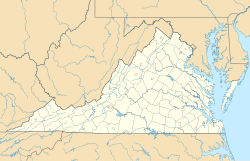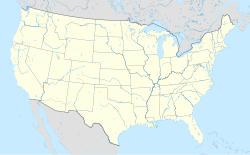Highland Springs, Virginia
Highland Springs, Virginia | |
|---|---|
 Highland Springs historical marker, part of the Highland Springs Historic District. | |
| Coordinates: 37°32′44″N 77°19′43″W / 37.54556°N 77.32861°W | |
| Country | |
| State | |
| County | |
| Area | |
• Total | 8.3 sq mi (21.6 km2) |
| • Land | 8.0 sq mi (20.7 km2) |
| • Water | 0.3 sq mi (0.9 km2) |
| Elevation | 171 ft (52 m) |
| Population (2020) | |
• Total | 16,604 |
| • Density | 2,000/sq mi (770/km2) |
| Time zone | UTC−5 (Eastern (EST)) |
| • Summer (DST) | UTC−4 (EDT) |
| ZIP code | 23075 |
| Area code | 804 |
| FIPS code | 51-37032[1] |
| GNIS feature ID | 1499559[2] |
Highland Springs is a census-designated place (CDP) located in Henrico County, Virginia, United States, 4.3 miles (7 km) east of Richmond. The population was 16,604 at the 2020 census.[3]
History
[edit]Edmund Sewell Read founded the community of Highland Springs in the 1890s as a streetcar suburb of Richmond on the Seven Pines Railway Company's electric street railway line between the city and the Seven Pines National Cemetery. There, many Union dead were interred, primarily as a result of battles nearby during the Civil War (1861–1865), most notably during the Peninsula Campaign of 1862. The potential traffic of visiting families to the Richmond area from out-of-town needing transportation to and from the cemetery was a motivating factor for inception of the new street railway.
Read came to the area from Boston in hopes of finding a suitable climate for his ailing wife. The natural springs in the area made it a suitable choice for the Read family, and apparently an inspiration for the new name.
Approximately mid-way along the new streetcar route from Richmond through eastern Henrico County, Read bought a 1,000-acre (400 ha) tract of land and divided it into lots. He laid out along the main street which was the pre-existing Nine Mile Road, new cross streets named in alphabetical order after plants, beginning from the west: Ash, Beech, Cedar, Daisy, Elm, Fern, Grove, Holly, Ivy, Juniper, Kalmia, Linden, Maple, Oak, Pine, Quince, Rose, and Spruce. One block south of and parallel to the Nine Mile Road, Read Street was named for its founder, Edmund Sewell Read.
The Sewells' large brick home is situated on the south side of Nine Mile Road between Grove and Holly, with Read Street to its rear. Today it serves as a medical office complex.
Geography
[edit]Highland Springs is located at 37°32′44″N 77°19′43″W / 37.54556°N 77.32861°W (37.545445, −77.328524).[4]
According to the United States Census Bureau, the CDP has a total area of 8.3 square miles (21.6 km2), of which 8.0 square miles (20.7 km2) is land and 0.35 square miles (0.9 km2), or 4.09%, is water.[5]
Demographics
[edit]| Census | Pop. | Note | %± |
|---|---|---|---|
| 1970 | 7,345 | — | |
| 1980 | 12,146 | 65.4% | |
| 1990 | 13,823 | 13.8% | |
| 2000 | 15,137 | 9.5% | |
| 2010 | 15,711 | 3.8% | |
| 2020 | 16,604 | 5.7% | |
| U.S. Decennial Census[6] 2010[7] 2020[8] | |||
2020 census
[edit]| Race / Ethnicity (NH = Non-Hispanic) | Pop 2010[7] | Pop 2020[8] | % 2010 | % 2020 |
|---|---|---|---|---|
| White alone (NH) | 4,580 | 3,712 | 29.15% | 22.36% |
| Black or African American alone (NH) | 10,303 | 11,475 | 65.58% | 69.11% |
| Native American or Alaska Native alone (NH) | 66 | 62 | 0.42% | 0.37% |
| Asian alone (NH) | 76 | 80 | 0.48% | 0.48% |
| Pacific Islander alone (NH) | 7 | 9 | 0.04% | 0.05% |
| Other race alone (NH) | 24 | 92 | 0.15% | 0.55% |
| Mixed race or Multiracial (NH) | 321 | 560 | 2.04% | 3.37% |
| Hispanic or Latino (any race) | 334 | 614 | 2.13% | 3.70% |
| Total | 15,711 | 16,604 | 100.00% | 100.00% |
2000 census
[edit]As of the census[1] of 2000, there were 15,137 people, 5,788 households, and 4,132 families residing in the CDP. The population density was 1,777.0 people per square mile (686.0/km2). There were 6,040 housing units at an average density of 709.0/sq mi (273.7/km2). The racial makeup of the CDP was 44.48% White, 51.83% African American, 0.62% Native American, 0.64% Asian, 0.01% Pacific Islander, 0.80% from other races, and 1.63% from two or more races. Hispanic or Latino of any race were 1.55% of the population.
There were 5,788 households, out of which 37.9% had children under the age of 18 living with them, 41.2% were married couples living together, 25.5% had a female householder with no husband present, and 28.6% were non-families. 23.4% of all households were made up of individuals, and 7.6% had someone living alone who was 65 years of age or older. The average household size was 2.59 and the average family size was 3.03.
In the CDP, the population was spread out, with 29.1% under the age of 18, 8.5% from 18 to 24, 31.1% from 25 to 44, 21.2% from 45 to 64, and 10.2% who were 65 years of age or older. The median age was 34 years. For every 100 females, there were 84.1 males. For every 100 females age 18 and over, there were 76.8 males.
The median income for a household in the CDP was $39,936, and the median income for a family was $42,887. Males had a median income of $33,117 versus $25,726 for females. The per capita income for the CDP was $17,979. About 8.5% of families and 10.4% of the population were below the poverty line, including 14.4% of those under age 18 and 6.5% of those age 65 or over.
Other information
[edit]Although no physical traces of the street railway remain in Highland Springs, old brick streetcar barns are extant both in Richmond, in the Church Hill area, and in Sandston at Seven Pines, where an unusual street configuration is attributed to the turning path of the old trolley cars at today's U.S. Route 60.
The new ABA team the Richmond Elite are based in Highland Springs, their home arena being Highland Springs High School.
Climate
[edit]The climate in this area is characterized by hot, humid summers and generally mild to cool winters. According to the Köppen Climate Classification system, Highland Springs has a humid subtropical climate, abbreviated "Cfa" on climate maps.[9]
References
[edit]- ^ a b "U.S. Census website". United States Census Bureau. Retrieved January 31, 2008.
- ^ "US Board on Geographic Names". United States Geological Survey. October 25, 2007. Retrieved January 31, 2008.
- ^ "Highland Springs CDP, Virginia". United States Census Bureau. Retrieved January 30, 2022.
- ^ "US Gazetteer files: 2010, 2000, and 1990". United States Census Bureau. February 12, 2011. Retrieved April 23, 2011.
- ^ "Geographic Identifiers: 2010 Demographic Profile Data (G001): Highland Springs CDP, Virginia". United States Census Bureau. Retrieved August 6, 2012.
- ^ "Decennial Census of Population and Housing by Decades". US Census Bureau.
- ^ a b "P2 Hispanic or Latino, and Not Hispanic or Latino by Race – 2010: DEC Redistricting Data (PL 94-171) - Highland Springs CDP, Virginia". United States Census Bureau.
- ^ a b "P2 Hispanic or Latino, and Not Hispanic or Latino by Race – 2020: DEC Redistricting Data (PL 94-171) - Highland Springs CDP, Virginia". United States Census Bureau.
- ^ Climate Summary for Highland Springs, Virginia
External links
[edit]- History of Highland Springs, Springer Connection website
- Henrico County Dept. of Recreation and Parks


